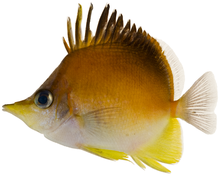Loading AI tools
Species of fish From Wikipedia, the free encyclopedia
Prognathodes aculeatus, the longsnout butterflyfish, is a species of butterflyfish found in tropical West Atlantic waters. It is also known as the butterbun, the Caribbean longsnout butterflyfish or Poey's butterflyfish.[2] This species should not be confused with the banded longsnout butterflyfish (Chelmon rostratus).[3]
| Prognathodes aculeatus | |
|---|---|
 | |
 | |
| Scientific classification | |
| Domain: | Eukaryota |
| Kingdom: | Animalia |
| Phylum: | Chordata |
| Class: | Actinopterygii |
| Order: | Acanthuriformes |
| Family: | Chaetodontidae |
| Genus: | Prognathodes |
| Species: | P. aculeatus |
| Binomial name | |
| Prognathodes aculeatus (Poey, 1860) | |
| Synonyms | |
|
Chaetodon aculeatus | |

The longsnout butterflyfish was first described in 1860 by Felipe Poey y Aloy and Albert C. L. G. Günther in two separate reports.[4][5] Between them the fish was given three separate scientific names each one in a different genus, though Poey's assignment of the species to Prognathodes is the only valid combination.[5][4][2] It was again described in 1880 by Sauvage who gave it yet another scientific name that has since been synonymized into P. aculeatus.[6]
An average of 2 to 3 in (5–7.5 cm) long, the longsnout butterflyfish is commonly known for its namesake long snout that is much more distinctive than those of similar species.[7] They also have a dusky to yellow colored stripe that runs almost vertically from the top of the head to the eyes (unlike the stripes on other butterflyfishes which extend past the eyes).[7]
The upper half of the longsnout butterflyfish is yellow that changes to orange and again darkens to brownish-orange.[7] The dorsal fin of the fish is usually black.[7]
Fairly common throughout its range, the longsnout butterflyfish is found on natural and artificial reefs, usually 30 to 200 ft (10–60 m) in depth.[2][8] It can be found off Florida, in the Gulf of Mexico, in the Caribbean Sea, and off the coast of Venezuela.[2]
Longsnout butterflyfish are much more solitary than many other members of their family.[7][8] They also inhabit deeper reefs and spend much of their time foraging in recesses for invertebrates.[2][9] It is also known to eat the tube feet of sea urchins and tube worm tentacles.[2][9] Unlike many other members of its family, the longsnout butterflyfish does not pick parasites from other fish.[10]
Seamless Wikipedia browsing. On steroids.
Every time you click a link to Wikipedia, Wiktionary or Wikiquote in your browser's search results, it will show the modern Wikiwand interface.
Wikiwand extension is a five stars, simple, with minimum permission required to keep your browsing private, safe and transparent.